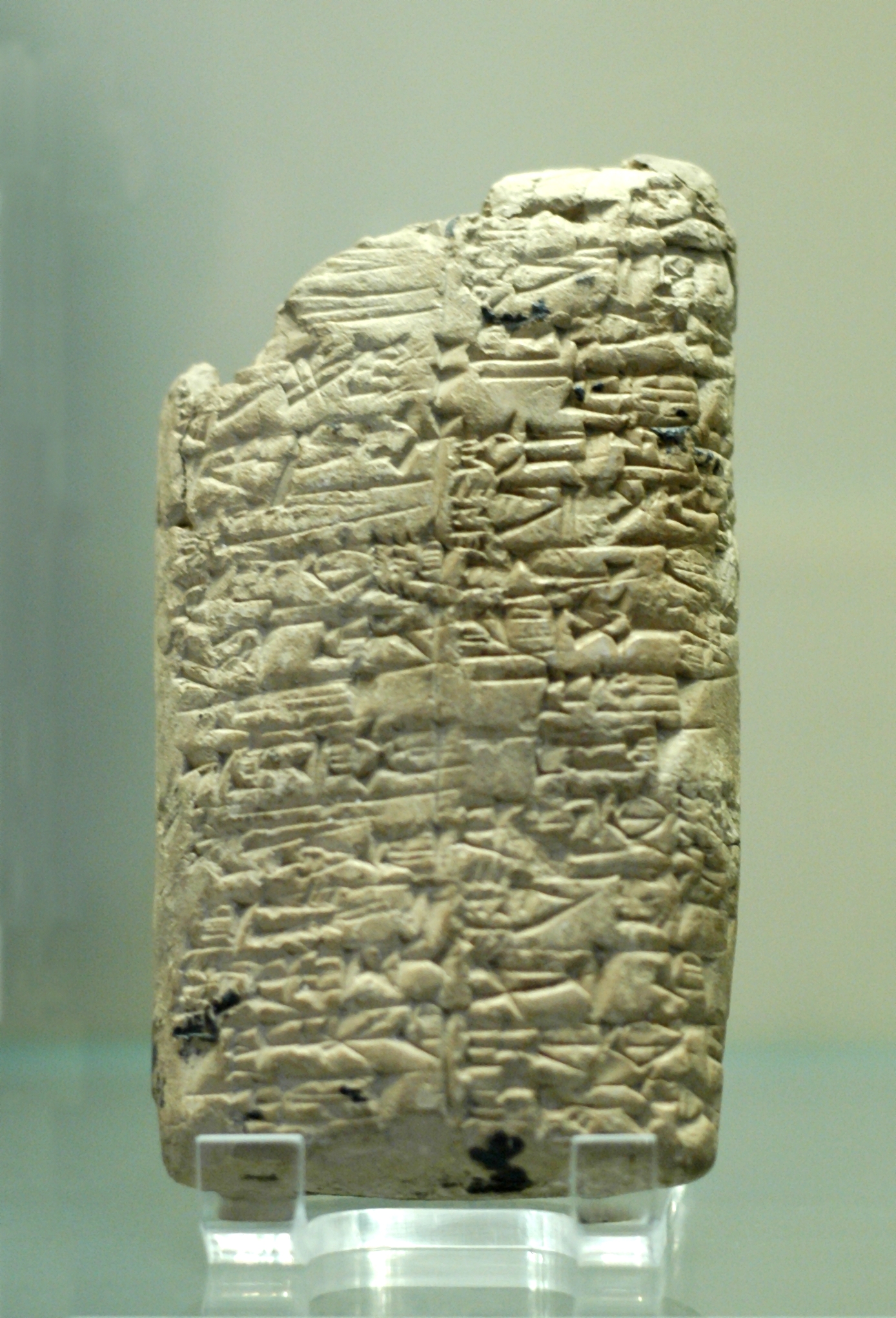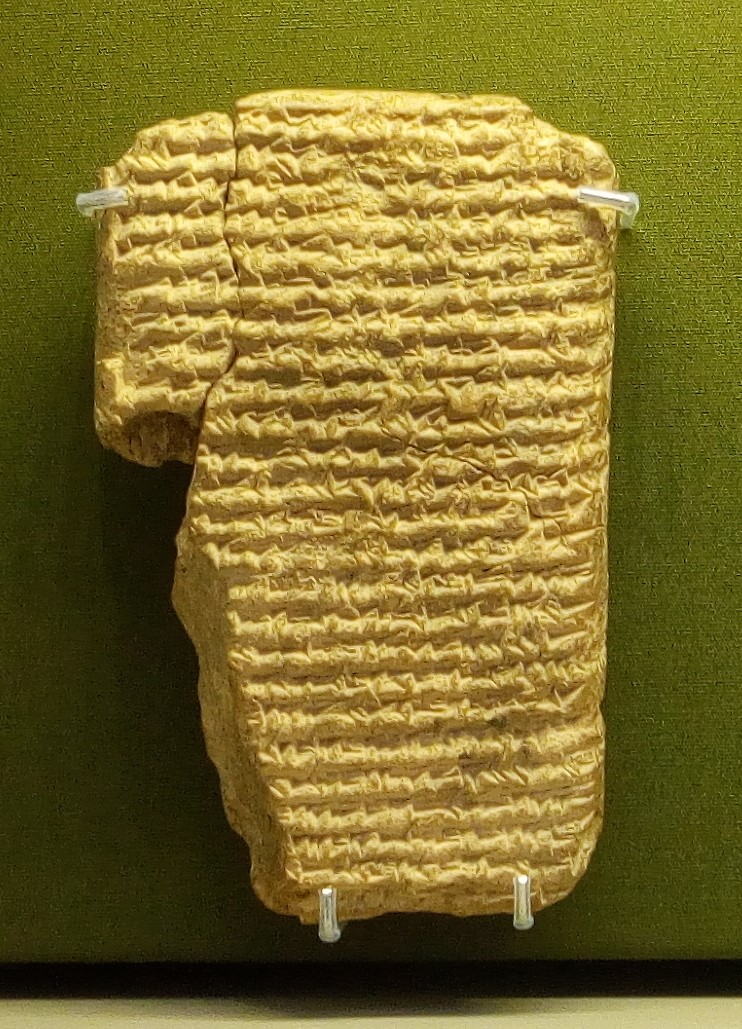|
Е urpu
The ancient Mesopotamian incantation series Е urpu begins ''enЕ«ma nД“peЕЎД“ ЕЎa ЕЎur-pu t'' 'epp'''uЕЎu'', вҖңwhen you perform the rituals for (the series) вҖҳBurning,вҖҷвҖқ and was probably compiled in the middle Babylonian period, ca. 1350вҖ“1050 BC, from individual incantations of much greater antiquity. It consisted of a long confessional of sins, ritual offences, unwitting breaches of taboos, offences against the moral or social order when the patient was unsure what act of omission he may have committed to offend the gods. Composed in Akkadian, its adjurations extend to nine clay tablets and, at Nineveh, Assurbanipal's scribes had canonized the series, fixing the sequence and providing a codicil at the bottom of each tablet providing the first line of the following tablet. Elsewhere, such as at Assur, the tablet order could vary. The text In contrast to the MaqlГ» incantation series, which was intended to counteract ''kiЕЎpЕ«'', black magic, it is a ritual against a ''mДҒm ... [...More Info...] [...Related Items...] OR: [Wikipedia] [Google] [Baidu] [Amazon] |
Akkadian Literature
Akkadian literature is the ancient literature written in the East Semitic languages, East Semitic Akkadian language (Assyrian people, Assyrian and Babylonian language, Babylonian dialects) in Mesopotamia (Akkadian Empire, Akkadian, Assyria and Babylonia) during the period spanning the Middle Bronze Age to the Iron Age (roughly the 25th to 4th centuries BC). Drawing on the traditions of Sumerian literature, the Akkadians, Assyrians and Babylonians compiled a substantial textual tradition of mythological narrative, legal texts, scientific works, letters and other literary forms. Conversely, Akkadian also influenced Sumerian literature. Literature in Akkadian society Most of what we have from the Assyrians and Babylonians was inscribed in cuneiform (script), cuneiform with a metal stylus on tablets of clay, called ''laterculae coctiles'' by Pliny the Elder; papyrus seems to have also been utilised, but not been preserved. There were libraries in most towns and temples in Sumer, Akk ... [...More Info...] [...Related Items...] OR: [Wikipedia] [Google] [Baidu] [Amazon] |
Mesopotamia
Mesopotamia is a historical region of West Asia situated within the TigrisвҖ“Euphrates river system, in the northern part of the Fertile Crescent. Today, Mesopotamia is known as present-day Iraq and forms the eastern geographic boundary of the modern Middle East. Just beyond it lies southwestern Iran, where the region transitions into the Iranian plateau, Persian plateau, marking the shift from the Arab world to Iran. In the broader sense, the historical region of Mesopotamia also includes parts of present-day Iran (southwest), Turkey (southeast), Syria (northeast), and Kuwait. Mesopotamia is the site of the earliest developments of the Neolithic Revolution from around 10,000 BC. It has been identified as having "inspired some of the most important developments in human history, including the invention of the wheel, the planting of the first cereal crops, the development of cursive script, mathematics, astronomy, and agriculture". It is recognised as the cradle of some of t ... [...More Info...] [...Related Items...] OR: [Wikipedia] [Google] [Baidu] [Amazon] |
Akkadian Language
Akkadian ( ; )John Huehnergard & Christopher Woods, "Akkadian and Eblaite", ''The Cambridge Encyclopedia of the World's Ancient Languages''. Ed. Roger D. Woodard (2004, Cambridge) Pages 218вҖ“280 was an East Semitic language that is attested in ancient Mesopotamia ( Akkad, Assyria, Isin, Larsa, Babylonia and perhaps Dilmun) from the mid- third millennium BC until its gradual replacement in common use by Old Aramaic among Assyrians and Babylonians from the 8th century BC. Akkadian, which is the earliest documented Semitic language, is named after the city of Akkad, a major centre of Mesopotamian civilization during the Akkadian Empire (вҖ“2154 BC). It was written using the cuneiform script, originally used for Sumerian, but also used to write multiple languages in the region including Eblaite, Hurrian, Elamite, Old Persian and Hittite. The influence of Sumerian on Akkadian went beyond just the cuneiform script; owing to their close proximity, a lengthy span of con ... [...More Info...] [...Related Items...] OR: [Wikipedia] [Google] [Baidu] [Amazon] |
Clay Tablet
In the Ancient Near East, clay tablets (Akkadian language, Akkadian ) were used as a writing medium, especially for writing in cuneiform, throughout the Bronze Age and well into the Iron Age. Cuneiform characters were imprinted on a wet clay tablet with a stylus often made of Reed (plant), reed (reed pen). Once written upon, many tablets were dried in the sun or air, remaining fragile. Later, these unfired clay tablets could be soaked in water and recycled into new clean tablets. Other tablets, once written, were either deliberately fired in hot kilns, or inadvertently fired when buildings were burnt down by accident or during conflict, making them hard and durable. Collections of these clay documents made up the first archives. They were at the root of the first library, libraries. Tens of thousands of written tablets, including many fragments, have been found in the Middle East. Most of the documents on tablets that survive from the Minoan civilization, Minoan and Mycenaean ... [...More Info...] [...Related Items...] OR: [Wikipedia] [Google] [Baidu] [Amazon] |
Nineveh
Nineveh ( ; , ''URUNI.NU.A, Ninua''; , ''NД«nЙҷwД“''; , ''NД«nawДҒ''; , ''NД«nwД“''), was an ancient Assyrian city of Upper Mesopotamia, located in the modern-day city of Mosul (itself built out of the Assyrian town of Mepsila) in northern Iraq. It is located on the eastern bank of the Tigris River and was the capital and largest city of the Neo-Assyrian Empire, as well as the largest city in the world for several decades. Today, it is a common name for the half of Mosul that lies on the eastern bank of the Tigris, and the country's Nineveh Governorate takes its name from it. It was the largest city in the world for approximately fifty years until the year 612 BC when, after a bitter period of civil war in Assyria, it was sacked by a coalition of its former subject peoples including the Babylonians, Medes, and Scythians. The city was never again a political or administrative centre, but by Late Antiquity it was the seat of an Assyrian Christian bishop of the Assyrian Ch ... [...More Info...] [...Related Items...] OR: [Wikipedia] [Google] [Baidu] [Amazon] |
Assurbanipal
Ashurbanipal (, meaning " Ashur is the creator of the heir")вҖ”or Osnappar ()вҖ”was the king of the Neo-Assyrian Empire from 669 BC to his death in 631. He is generally remembered as the last great king of Assyria. Ashurbanipal inherited the throne as the favored heir of his father Esarhaddon; his 38-year reign was among the longest of any Assyrian king. Though sometimes regarded as the apogee of ancient Assyria, his reign also marked the last time Assyrian armies waged war throughout the ancient Near East and the beginning of the end of Assyrian dominion over the region. Esarhaddon selected Ashurbanipal as heir 673. The selection of Ashurbanipal bypassed the elder son Shamash-shum-ukin. Perhaps in order to avoid future rivalry, Esarhaddon designated Shamash-shum-ukin as the heir to Babylonia. The two brothers jointly acceded to their respective thrones after Esarhaddon's death in 669, though Shamash-shum-ukin was relegated to being Ashurbanipal's closely monitored vassal. Mu ... [...More Info...] [...Related Items...] OR: [Wikipedia] [Google] [Baidu] [Amazon] |
Assur
AЕЎЕЎur (; AN.Е AR2KI, Assyrian cuneiform: ''AЕЎ-ЕЎurKI'', "City of God AЕЎЕЎur"; ''ДҖЕЎЕ«r''; ''AОёur'', ''ДҖЕЎЕ«r''; ', ), also known as Ashur and Qal'at Sherqat, was the capital of the Old Assyrian city-state (2025вҖ“1364 BC), the Middle Assyrian Empire (1363вҖ“912 BC), and for a time, of the Neo-Assyrian Empire (911вҖ“609 BC). The remains of the city lie on the western bank of the Tigris River, north of the confluence with its tributary, the Little Zab, in what is now Iraq, more precisely in the al-Shirqat District of the Saladin Governorate. Occupation of the city itself continued for approximately 3,000 years, from the Early Dynastic Period to the mid-3rd century AD, when the city was sacked by the Sasanian Empire. The site is a World Heritage Site and was added to that organisation's list of sites in danger in 2003 as a result of a proposed dam, which would flood some of the site. It has been further threatened by the conflict that erupted following the US-led ... [...More Info...] [...Related Items...] OR: [Wikipedia] [Google] [Baidu] [Amazon] |
MaqlГ»
The MaqlГ», вҖңburning,вҖқ series is an Akkadian incantation text which concerns the performance of a rather lengthy anti-witchcraft, or ''kiЕЎpЕ«'', ritual. In its mature form, probably composed in the early first millennium BC, it comprises eight tablets of nearly a hundred incantations and a ritual tablet, giving incipits and directions for the ceremony. This was performed over the course of a single night in the month of Abu (July/August) when the perambulations of the spirits to and from the netherworld made them especially vulnerable to its spells. It was the subject of a letter from the exorcist NabГ»-nДҒdin-ЕЎumi and the Assyrian king Esarhaddon Esarhaddon, also spelled Essarhaddon, Assarhaddon and Ashurhaddon (, also , meaning " Ashur has given me a brother"; Biblical Hebrew: ''КҫД’sar-бёӨaddЕҚn'') was the king of the Neo-Assyrian Empire from 681 to 669 BC. The third king of the S .... It seems to have evolved from an earlier short-form with only ten incantations t ... [...More Info...] [...Related Items...] OR: [Wikipedia] [Google] [Baidu] [Amazon] |
Erica Reiner
Erica Reiner (4 August 1924 – 31 December 2005) was an American Assyriologist and author. From 1974, she was editor of the '' Chicago Assyrian Dictionary'', which was published in 21 volumes over 55 years, being completed in 2011 after her death. Reiner was associated with the Oriental Institute at the University of Chicago. Her work concentrated on developing the '' Chicago Assyrian Dictionary'', the basic reference work for understanding the Akkadian language, the predominant language of Mesopotamia from 2400 BC to 100 AD. Early life and education Erica Reiner was born in Budapest, Hungary. She graduated from the University of Budapest in 1948. She went to the University of Chicago in 1952 for graduate work and received a Ph.D. in 1955. Academic career Reiner joined the Chicago faculty in 1956. Extensive documentation and planning for the ''Chicago Assyrian Dictionary'' had been underway at the university since 1921. Reiner, along with A. Leo Oppenheim, led the team ... [...More Info...] [...Related Items...] OR: [Wikipedia] [Google] [Baidu] [Amazon] |
Marduk
Marduk (; cuneiform: Dingir, бөҲAMAR.UTU; Sumerian language, Sumerian: "calf of the sun; solar calf"; ) is a god from ancient Mesopotamia and patron deity of Babylon who eventually rose to prominence in the 1st millennium BC. In Babylon, Marduk was worshipped in the temple Esagila. His symbol is the spade and he is associated with the MuЕЎбё«uЕЎЕЎu. By the 1st millennium BC, Marduk had become astrologically associated with the planet Jupiter. He was a prominent figure in ancient near eastern cosmology, Babylonian cosmology, especially in the EnЕ«ma EliЕЎ creation myth. Name The name of Marduk was solely spelled as dAMAR.UTU in the Old Babylonian Period, although other spellings such as MES and dЕ A.ZU were also in use since the Kassite Period. In the 1st millennium BC, the ideograms dЕ U and KU were regularly used. The logogram for Adad is also occasionally used to spell Marduk. Texts from the Old Babylonian period support the pronunciation Marutu or ... [...More Info...] [...Related Items...] OR: [Wikipedia] [Google] [Baidu] [Amazon] |







